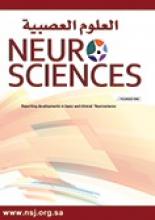To the Editor
We have read with interest the article by Khan et al about a retrospective observational study of 5 patients with autoimmune epilepsy associated with antibodies against NMDAR (n=2) and GAD65 (n=3).1 One patient had malignancy and 4 patients benefited from rituximab.1 The study is impressive, but several points require discussion.
First, a causal relationship between the GAD65 antibodies in patient-1, patient-4, and patient-5 could not be confirmed. The first argument against a causal relationship is that all 3 patients had epilepsy since they were 14 (patient-1), 34 (patient-4), and 15 years (patient-5) old, i.e. 10, 4, and 20 years before detection of GAD65 or NMADR antibodies. This long latency between onset of epilepsy and the detection of GAD65 or NMDAR antibodies makes a causal relationship between these antibodies and epilepsy rather unlikely. If epilepsy was truly due to GAD65 or NMDAR antibodies, the course of epilepsy would have been more severe. A second argument is that in patient-1 and patient-5 antibodies were only determined in serum but not in the cerebrospinal fluid (CSF).1 A third argument against a causal relationship is that 2 patients had mesial temporal sclerosis,1 suggesting temporal lobe epilepsy, which often begins with febrile seizures in childhood.
Second, the workup for malignancy in patients 1, 2, and 3 was inadequate.1 Autoimmune encephalitis is associated with antibodies against various neuronal structures in approximately half of patients with immune encephalitis.1 Four classes of antibodies are distinguished, surface antibodies, intracellular antibodies, synaptic antibodies, and antibodies of undetermined significance.2 In 90% of cases, intracellular antibodies such as NMDAR antibodies in patient-2 and patient-5, are associated with malignancy and often do not respond to treatment. GAD65 antibodies can also be associated with malignancy.3 Therefore, it is crucial to screen these patients for malignancies. However, CT of chest, abdomen, and pelvis, as well as gynaecological examinations are not sufficient for malignancy screening. Patient-1, 2, and 3 should have undergone mammography, gastroscopy, colonoscopy, and determination of tumour markers in addition to chest and abdominal CT. Patient-4 and patient-5 did not undergo any screening for malignancy at all.
Third, it was not specified which MRI modalities were used and whether contrast agent was administered or not. The administration of contrast agent is necessary to clarify suspected immune encephalitis. After application of contrast agent enhancing lesions may be noted. On diffusion-weighted (DWI) images in immune encephalitis, the encephalitic lesions are usually isointense, whereas in infections encephalitis, especially herpes simplex encephalitis, encephalitic lesions are hyperintens.4
Fourth, patient-3 received incomprehensible long-term anti-seizure therapy with levetiracetam (500mg/d) and lacosamide (200mg/d).1 The dosage of 500mg levetiracetam is subtherapeutic for a patient of average weight, normal liver and renal function, and no hematologic impairment. Were the serum levels of levetiracetam within the therapeutic range? We should know the reason why such a low dosage was given. Did the patient have side effects from levetiracetam?
Antibodies to GAD65 are associated not only with autoimmune encephalitis but also with stiff person syndrome and cerebellar ataxia, Were any of these additional features present in the 3 patients with positive GAD675 antibodies? GAD65 is a crucial enzyme for the formation of GABA, the main inhibitory neurotransmitter. The T-cell mediated immune response appears to be important in the pathogenesis of immune encephalitis. GAD65-associated encephalitis may also be associated with meningitis (enhancement of the meninges).5 Was there evidence of meningeal involvement in the three included patients with GAD65 antibodies?
We disagree that one patient had malignancy.1 The cystic teratoma in patient-3 is not a malignancy per se. Only if the number of immature cells is greater than 10%, is malignancy suspected, and if their number exceeds 50%, malignancy is certain. What were the histological findings in patient-3?
In patient-4 the case description does not state which antibodies were found and whether they were found in the serum or the CSF.1 Only Table 1 mentions that the patient had GAD65 antibodies.
In summary, patients with suspected immune epilepsy require a comprehensive diagnostic work-up, including a detailed history, clinical exam, multimodal MRI, use of contrast medium, and extensive CSF studies, including determination of antibodies associated with immune encephalitis in the CSF.
Reply from the Author
No reply from the authors
- Copyright: © Neurosciences
Neurosciences is an Open Access journal and articles published are distributed under the terms of the Creative Commons Attribution-NonCommercial License (CC BY-NC). Readers may copy, distribute, and display the work for non-commercial purposes with the proper citation of the original work.






